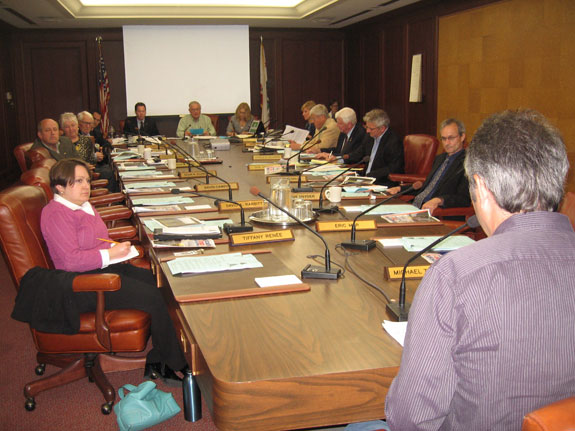Golden Gate Bridge directors today tabled their staff’s surprise proposal for a 10 mph speed limit for bicycles after outraged cycling advocates denounced the plan as everything from a “half-baked idea” to a “solution in search of a problem.”
The bridge’s Building and Operating Committee received more than 60 complaints prior to the hearing, then heard another hour’s worth of criticism from several prominent bicycling organizations that were intentionally excluded from a year-long, $25,000 study of cycling safety.
“Creating controversy and outrage among cyclists is hardly the proper way to engage the community,” San Francisco Triathlon Club member Dino Piacentini told the committee. “I’m a little concerned about the anger and frustration in the community.”
After hearing concerns from the bicycle groups, and several more from district directors, the committee put off the vote indefinitely, directing its staff to work with the cycling community to refine the proposal, a process that is likely to take months.
While cyclists won a reprieve, they’ll still have to slow down on the bridge this summer. On May 9, the bridge will close its bike-only western sidewalks for four months of maintenance work, forcing thousands of daily cyclists to share the jammed eastern sidewalks with up to 10,000 pedestrians. Director Barbara Pahre suggested a need for an interim plan to deal with the crowding, but no ideas came forth.
Stealth Planning
This week’s sudden call for the speed limit came after what General Manager Denis Mulligan called a “confidential” study by Alta Planning & Design. Alta officials told Streetsblog they were instructed by the district not to discuss the report.
In addition to a 10 mph speed limit and $100 fines for most of the bridge, the plan would impose a 5 mph limit around the towers and when maintenance work is underway. Maintenance workers are a constant presence on the bridge on weekdays. The proposal also called for creating separate lanes for bikes and pedestrians on the bridge’s eastern sidewalk. Finally, the plan would also ban unicycles, bikes with seats more than 4 feet high.
Everyone at the hearing agreed safety is important. Mulligan drove that home by noting one cyclist became a quadriplegic after a high-speed, head-on crash. But the secrecy surrounding the planning project reflected a still-unexplained aberration for the district, which typically works closely with the bicycling groups on safety and transit issues.
“We were quite surprised to get our first notice of this study and proposal a few days ago,” Andy Thornley, policy director for the 12,000-member San Francisco Bicycle Coalition, told the committee. “We certainly could have helped change the proposal to avoid much of the negative media and public outcry … Shouldn’t you get a proposal that is properly developed instead of a half-baked idea that we’re going to spend months working on?”
Marin County Bicycle Coalition Advocacy Director Andy Peri said his group’s “primary” goal is to enhance safety, but it “doesn’t want to see policies that are going to discourage bicycling.” He urged the committee to allow as much time as needed to come up with a better plan.
Similarly, Bike and Roll Policy Director David Hoffman noted his company rents 100,000 bikes a year to tourists, with 90 percent of them heading over the bridge.
“Frankly, I’m a little disappointed that I’m sitting at a table discussing this with the bridge district rather than having the bicycle rental companies involved in the process of this study,” Hoffman said. “It’s incredibly important to involve your stakeholders – the people who are sending hundreds of thousands of bicycles over the bridge every year – in this process.”
Mission Cycling member Neil Gehani said, “I’m wondering if this is a solution in search of a problem rather than trying to solve a real problem.”
Although Mulligan hoped for a 30-day delay, the process is likely take months. When the plan does come back to the committee, there’s a good chance it will address a broader range of topics. Several of the organizations stressed that they were eager to work with the district on safety issues that go beyond the speed of the bicycle.
Crash Causes

The Alta report focused almost exclusively on speed, which was cited as a primary factor in just 39 percent of the 164 bike crashes on the bridge over the 10-year period from 2000-2009. Absent from the discussion were the causes of the 61 percent of the crashes that weren’t attributed to speed, such as slippery metal plates on the bikepath or gusty winds around the towers – problems that could be mitigated through improved design.
District Director Dave Snyder said he’d like to know if the other cyclists hit something, were drunk or crashed for some other reason.
The bridge sidewalk is 10 feet wide with clear sightlines, but narrows to 5.5 feet near the pylons where the bridge cable is anchored, leaving little margin for error as two oncoming cyclists pass each other. The path is just 7.5 feet wide as cyclists roll into the blind turns at the towers, where some cyclists get distracted by the wind and the bumpy plates on the sidewalk.
While those conditions will surely be addressed in coming weeks, some directors already seemed amenable to compromises. Snyder, for example, questioned whether it’s really necessary to ban unicycles, which was part of the staff proposal. And Director Dick Grosboll suggested it might be possible to exclude early morning commuters from the speed limit, if one is ever adopted.






